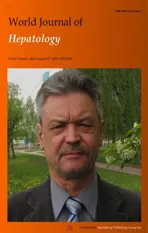Outcomes of patients with post-hepatectomy hypophosphatemia: A narrative review
2022-09-01KaiSiangChanSwethaMohanVishalShelat
Kai Siang Chan, Swetha Mohan, Vishal G Shelat
Kai Siang Chan, Vishal G Shelat, Department of General Surgery, Tan Tock Seng Hospital,Singapore 308433, Singapore
Swetha Mohan, Vishal G Shelat, Lee Kong Chian School of Medicine, Nanyang Technological University, Singapore 308232, Singapore
Abstract Phosphate is an essential electrolyte for proper mineralisation of bone, buffering of urine, and diverse cellular actions. Hypophosphatemia (HP) is a clinical spectrum which range from asymptomatic to severe complications such as neuromuscular and pulmonary complications, or even death. Post-hepatectomy HP(PHH) has been reported to be 55.5%-100%. Post-hepatectomy, there is rapid uptake of phosphate and increased mitotic counts to aid in regeneration of residual liver. Concurrently, PHH may be due to increased urinary phosphorous from activation of matrix extracellular phosphoglycoprotein in the injured liver,which decreases phosphate influx into hepatocytes to sustain adenosine triphosphate synthesis. A literature review was performed on PubMed till January 2022. We included 8 studies which reported on impact of PHH on post-operative outcomes. In patients with diseased liver, PHH was reported to have either beneficial or deleterious effects on post-hepatectomy liver failure (PHLF),morbidity and/or mortality in various cohorts. In living donor hepatectomy,PHLF was higher in PHH. Benefits of correction of PHH with reduced postoperative complications have been shown. Correction of PHH should be done based on extent of PHH. Existing studies were however heterogenous; further studies should be conducted to assess PHH on post-operative outcomes with standardized phosphate replacement regimes.
Key Words: Hepatectomy; Hepatocellular Carcinoma; Hypophosphatemia; Phosphates;Liver neoplasms; Liver transplantation
lNTRODUCTlON
Phosphate is an essential electrolyte which is involved in several bodily functions. It is necessary for proper mineralisation of bone, buffering of urine, and diverse cellular actions such as energy metabolism, proliferation and specific functions of differentiated cells[1]. Given its essential roles,aberrancy in phosphate levels result in adverse impact on the body. Normal adult serum phosphate ranges from 0.81-1.45 mmol/L (2.5-4.5 mg/dL). Hypophosphatemia (HP) is defined as an adult serum phosphate level < 0.81 mmol/L (< 2.5 mg/dL)[2]. HP may also be subdivided according to its severity:mild (0.65-0.81 mmol/L, or 2.0-2.5 mg/dL), moderate (0.32-0.65 mmol/L, or 1.0-2.0 mg/dL) and severe(< 0.32 mmol/L, or < 1.0 mg/dL)[2]. The clinical presentation of HP is a spectrum; patients may be asymptomatic or present with mild symptoms such as fatigue, weakness or anorexia. However, HP may result in severe complications such as neuromuscular disturbances including encephalopathy, seizures,coma, pulmonary complications such as respiratory failure (in view of respiratory muscle weakness),cardiovascular complications such as impaired myocardial performance, hemolytic anemia, or even death[3]. Sequelae of patients with underlying malignancy such as nausea, vomiting and loss of appetite may result in HP from reduced dietary intake[4].
HP has been reported to be 0.2%-0.3% in all inpatients, 30% in intensive care unit (ICU) patients and 60-85% in sepsis[5-7]. Post-operative HP is also commonly reported following major abdominal surgery,including liver resection (hepatectomy)[8,9]. Post-hepatectomy HP (PHH) has been reported to be 55.5-100%[10-14]. Literature on the impact of PHH however, remains controversial. Immediately following hepatectomy, there is a drop in serum phosphate due to increased phosphate uptake in the regenerating injured liver, as well as increased urinary loss of phosphorous from activation of matrix extracellular phosphoglycoprotein in the injured liver[15,16]. Some studies have reported improved recovery of initial liver insufficiency in PHH, yet others reported increased major morbidity (cardiorespiratory,infections and haemorrhage)[10,11]. These studies were heterogenous in the extent of hepatectomy and PHH. In view of the lack of high quality evidence, this manuscript aims to review the pathophysiology,etiology, clinical significance and prognostic impact of PHH.
PATHOPHYSlOLOGY AND ETlOLOGY
The homeostasis of phosphate is a complex process. Phosphate regulation is maintained through intestinal phosphate absorption, renal phosphate excretion, and equilibrium of extracellular phosphate with that in bone or intracellular fluid[1]. Intracellular shift of phosphate is enhanced by respiratory alkalosis and insulin. Dietary sources of phosphate include eggs, milk, meat, soy-based products and foods with additives and preservatives[17]. Causes of HP include reduced dietary uptake, impaired intestinal absorption, increased phosphate excretion and intracellular shift of phosphate[2]. Metabolism of phosphate is closely linked to the calcium-parathyroid hormone (PTH)-vitamin D axis. Serum phosphate is mediated by PTH and 1,25 dihydroxyvitamin D (1,25(OH)2D), which play critical roles in the regulation of phosphate homeostasis in the intestines, bone and kidneys; PTH is produced by the parathyroid glands and influence phosphate and calcium levels through the following: (1) Stimulation of bone resorption resulting in an increase in serum calcium and phosphate; (2) Inhibition of resorption of phosphate from tubular fluid in the kidneys resulting in decrease in serum phosphate; and (3)Stimulation of conversion of cholecalciferol to calcitriol in the kidney, whereby calcitriol is responsible for intestinal absorption of phosphate and calcium[18]. General causes of post-operative HP following major abdominal surgery has been postulated to be due to the result of hemodilution caused by bleeding or fluid administration during surgery[19]. Other contributory factors include diabetic ketoacidosis and refeeding syndrome especially in the context of malignancy and associated malnutrition[20]. Figure 1 summarizes the pathophysiology and etiology outlining HP.
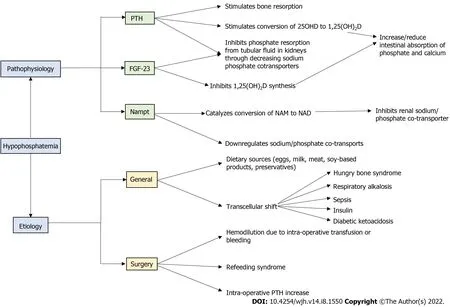
Figure 1 Pathophysiology and etiology outlining hypophosphatemia. 1,25(OH)2D: 1,25 dihydroxyvitamin D; 25OHD: 25-hydroxyvitamin D; FGF-23:Fibroblast growth factor-23; NAD: Nicotinamide adenine dinucleotide; NAM: Nicotinamide; Nampt: Nicotinamide phosphoribosyltransferase; PTH: Parathyroid hormone.
Liver tissue contains 0.3% phosphate by weight[21]. PHH has been traditionally thought to be due to the increased metabolic demands by the regenerating liver[22]. Post-hepatectomy, there is rapid uptake of phosphate and increased mitotic counts in the regenerating residual liver, resulting in PHH[15].However, it has been postulated that there are several pathophysiologic mechanisms behind HP following hepatectomy. Surgery has been shown to result in elevated PTH of up to 9 times intraoperatively[23]. PTH reduces renal proximal tubular phosphate uptake by decreasing the abundance of renal sodium phosphate cotransporters (Npt2a, Npt2c, and PiT-2) in the renal proximal tubule, resulting in increased fraction of excretion of phosphate (Fe-P) with resulting HP[24]. A study by Nafidiet alon 18 patients who underwent hepatectomy showed that intact-PTH (I-PTH) had significant increase on post-operative day (POD) 1 (from 4.5 ± 0.3 to 8.8 ± 0.9 pmol/L,P <0.01)[25]. Phosphate levels was negatively correlated with I-PTH (r = -0.56:P= 0.024) on POD1, and Fe-P was positively correlated with I-PTH (r= 0.52:P= 0.047)[25]. An alternative explanation for PHH is secondary to increased urinary phosphorous loss due to the release of cathepsin B from activation of matrix extracellular phosphoglycoprotein in the injured liver[16,26]. This activation of matrix extracellular phosphoglycoprotein results in decreased concentration of phosphate influx into hepatocytes to sustain adenosine triphosphate(ATP) synthesis[16]. This is in contrary to the hypothesis that PHH is a result of influx of phosphate into liver for ATP synthesis which aids liver regeneration[22].
Phosphatonins, which are phosphaturic peptides that decrease renal sodium-dependent cotransport of phosphate, may also be responsible for PHH[27]. Fibroblast Growth Factor-23 (FGF-23) inhibits 1,25(OH)2D synthesis and reduces the expression and activity of the sodium phosphate cotransporters in the renal proximal tubule, resulting in reduced intestinal and renal phosphate absorption[28]. FGF-23 is elevated in chronic kidney disease in view of higher phosphate and calcium concentrations[29].Elevation in FGF-23 (which results in HP) has been demonstrated to be a strong predictor of mortality independent of renal function in patients with end-stage liver disease on transplant waiting list; this has been postulated to be due to the toxic effects of FGF-23 and increased risk of infections at abovephysiological levels[30,31]. However, the effect of hepatectomy on FGF-23 levels has not been demonstrated[23].
Recently, translational studies have shown the role of nicotinamide (NAM) and nicotinamide phosphoribosyltransferase (Nampt) in the pathophysiology of PHH[32]. Nampt catalyzes rate-limiting step in conversion of NAM to nicotinamide adenine dinucleotide (NAD) which is essential for cellular metabolism, energy production and deoxyribonucleic acid repair[33]. NAM inhibits intestinal and renal sodium-dependent inorganic phosphate (Na/Pi) transport system in rats[34]. Following hepatectomy,there is increase in Nampt and NAM. Excess Nampt and NAM influx in proximal tubular cells of the kidney results in downregulation of NaPi-IIa and NaPi-IIc protein levels[32]. In addition, Nampt catalyzes conversion of NAM to NAD, which inhibits renal Na/Pi transport in response to metabolic stimuli, resulting in PHH with hyperphosphaturia[35].
ADVANTAGES OF HYPOPHOSPHATEMlA
Search strategy
A literature review was performed on PubMed from inception till 11 January 2022 using a combination of search terms “hypophosphatemia” AND (“liver resection” OR “post-hepatectomy liver failure” OR“post-hepatectomy insufficiency”). The detailed search strategy is appended in Supplementary material(Supplementary Table 1). We obtained a total of 65 studies, of which 10 studies reported impact of HP on outcomes following hepatectomy; 2 studies did not have full-text available and had insufficient data in the abstract and hence were not included in our review[36,37]. We included 8 studies which reported on the impact of PHH on post-operative outcomes[10-14,38-40]. Table 1 summarizes the study characteristics of all included studies. Table 2 summarizes the median phosphate levels and difference in postoperative outcomes following liver resection for both healthy liver donors and diseased patients with PHHvsnormophosphatemia (NP). Where applicable, overall mean and standard deviation values were combined from individual subgroups using methods described by Altmanet al[41]. Figure 2 is a schematic representation of the advantages and disadvantages of PHH on post-operative outcomes with their respective proposed pathophysiology.

Table 1 Summary of study characteristics of all included studies in the literature review
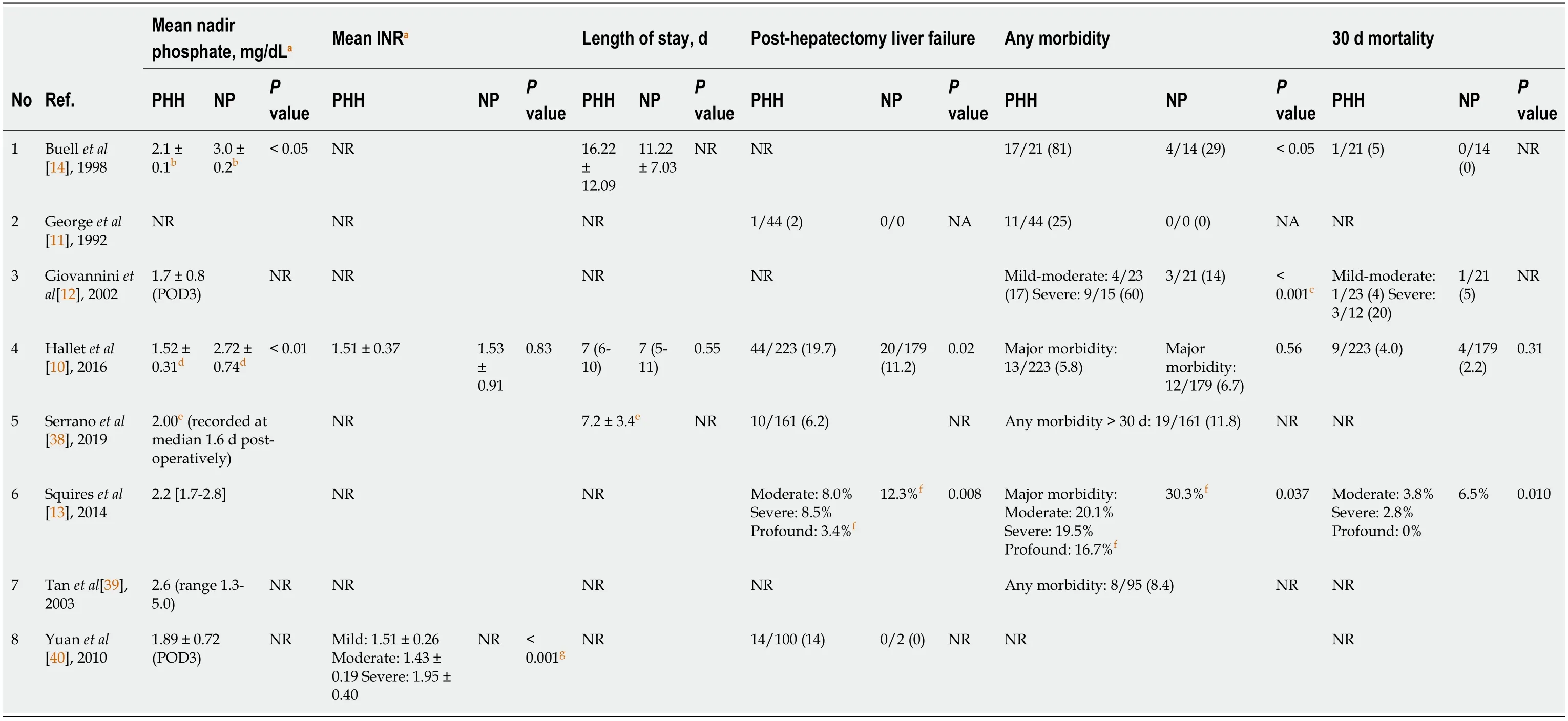
Table 2 Summary of laboratory values and post-operative outcomes comparing patients with post-hepatectomy hypophosphatemia and normophosphatemia
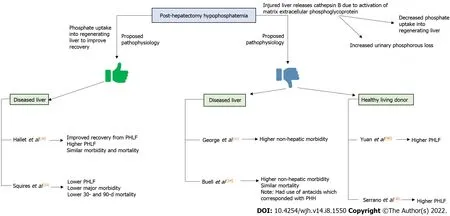
Figure 2 Schematic diagram summarizing the postulated pathophysiology of the impact of post-hepatectomy hypophosphatemia on post-operative outcomes, as well as summary of the advantages (green) and disadvantages (blue) of post-hepatectomy hypophosphatemia in existing literature on post-operative outcomes.PHLF: Post-hepatectomy liver failure.
Summary of evidence on PHH
Literature has shown benefits of PHH with improvement in recovery from post-hepatectomy liver failure (PHLF). A retrospective study by Halletet al[10] in 2016 investigated on the impact of PHH on post-operative liver function and recovery in 402 patients who underwent hepatectomy. They investigated on initial liver insufficiency (ILI), which was defined as serum bilirubin > 50 μmol/L and INR >1.7 within 5 d post-operatively; patients who had PHH were also more likely to have ILI compared to NP (n= 44/223 (19.7%)vs n= 20/179 (11.2%),P= 0.02). However, they showed that of all patients with ILI, more patients with HP recovered from ILI compared to those with NP (90.9%vs65.0%,P= 0.03).
Incidence of PHLF is reported to be 0.7%-35%, varying based on pre-operative liver function,underlying pathology and co-morbidities[42]. Definition of PHLF is controversial with lack of standardized definitions; the “50-50” criteria (serum bilirubin > 50μL/L and prothrombin time < 50% of normal on POD 5) was proposed by Balzanet al[43]. Consensus by the International Study Group of Liver Surgeries (ISGLS) in 2011 defined PHLF as post-operatively acquired deterioration in the ability of the liver (in patients with normal and abnormal liver function) to maintain its synthetic, excretory and detoxifying function, characterised by increase in the INR and hyperbilirubinemia on or after POD 5:Grade A (defined as abnormal laboratory values without change in clinical management), B (defined as requiring deviation from regular clinical management but without need for invasive treatment) and C(defined as requiring need for invasive treatment) has mortality of 0%, 12% and 54% respectively[44,45]. Intravenous phosphate replacement was given based on the serum phosphate levels in the study by Halletet al[10] (Table 1). It is possible that more aggressive phosphate replacement in patients with PHH may have resulted in better improvement in ILI by creating influx of phosphate into hepatocytes to assist in liver regeneration[22]. Apart from liver (dys) function however, there was no difference in postoperative outcomes between PHH and NP in their study; there was no association between PHH and length of stay (PHH: median 7 (interquartile range (IQR) 6-10) dvsNP: median 7 (IQR 5-11) d,P= 0.55),morbidity (PHH:n= 13/223 (5.8%)vsNP:n= 12/179 (6.7%),P= 0.56) and mortality (PHH:n= 3/223(1.3%)vsNP:n= 4/179 (2.2%),P= 0.50). It is important to note the definition of PHH defined in their study (PHH was defined as ≤ 0.65 mmol/L) correlates to moderate HP instead. Benefits of improved recovery from ILI in patients with PHH may only be seen in moderate or severe PHH, or due to more aggressive phosphate replacement in those subgroups.
Similar to the study by Halletet al[10], Squireset al[13] demonstrated improved liver function with PHH. A retrospective study by Squireset alon 719 patients who underwent major hepatectomy showed that NP (defined as > 2.5 mg/dL or > 0.81 mmol/L) was associated with highest incidence of PHLF(12.3%), major complications (30.3%), 30 d mortality (6.5%) and 90 d mortality (7.1%), compared to moderate, severe or profound PHH[13]. Profound PHH had the lowest incidence of post-operative complications (PHLF: 3.4%,P= 0.008; major complications: 16.7%,P= 0.037; 30 d mortality: 0,P= 0.010;90 d mortality: 3.4%,P= 0.166). Phosphate replacement was given based on surgeon discretion (n=469/719, 69%). Multivariate analysis also showed that phosphate > 0.78 mmol/L on POD 2 is independently associated with significant risk of PHLF (Hazards ratio (HR) 1.78, 95% confidence interval (CI): 1.02-3.17,P= 0.048), major complications (HR 1.57, 95%CI: 1.02-2.47,P= 0.049), 30 d mortality (HR 2.70, 95%CI: 1.08-6.76,P= 0.031) and 90 d mortality (HR 2.51, 95%CI: 1.03-6.15,P= 0.044).Following hepatectomy, liver regeneration with hepatocyte proliferation and deoxyribonucleic acid synthesis begins immediately and is mostly completed after 72 h[46,47]. Failure to reach PHH suggest the lack of phosphate uptake for ATP synthesis in the liver, resulting in higher incidence of PHLF. This was supported by increased PHLF and mortality in patients who had phosphate nadir after POD3[13].Unlike the study by Halletet al[10] which showed increased PHLF, Squireset al[13] showed reduced PHLF with increased severity of PHH. This may be attributed to the patient selection in studies, where Squireset al[13] included patients with normal to profound PHH, whereas Halletet al[10] only included patients with normal to moderate PHH. Severe and profound PHH may be more frequently seen in major hepatectomy in view of the extent of liver resection and burden on the regenerating liver. Failure to reach severe or profound PHH may indicate the liver’s inability for adequate regeneration, and hence, worse outcome with higher PHLF during the initial post-operative day[10].
DlSADVANTAGES OF HYPOPHOSPHATEMlA
Hepatectomy for liver pathology
The adverse effect of HP following hepatectomy was first shown by George and Shiu in 1992, where a retrospective study was conducted on 44 patients who underwent right or extended right hepatectomy[11]. They showed that severe HP (< 1.0 mg/dL, or < 0.32 mmol/L) was associated with increased major post-operative complications (cardiorespiratoryn= 5, infectionsn= 4, haemorrhagen= 1, liver failuren= 1,P <0.001). Protective effect of early phosphate replacement (P <0.05) with fewer complications was also described, highlighting the importance of normalization of phosphate post-operatively. However,there is a lack of information on the extent of replacement and other outcome measures such as mortality.
Similarly, a retrospective study by Buellet al[14] in 1998 on 35 patients who underwent major hepatectomy and/or cryosurgery showed significantly higher post-operative complications (pancreatitis, pulmonary infections, gastrointestinal bleed, wound infection and ileus) in PHH compared to NP(HP:n= 17/21 (80%)vsNP: 4/14 (28%),P <0.05)[14]. Length of hospital stay was 5 d longer (clinically but not statistically significant) in patients who had PHH compared to NP. Mortality was comparable between both PHH and NP. The authors defined PHH as phosphate < 0.81 mmol/L. Phosphate replacement was also initiated from POD 1 when phosphate < 0.97 mmol/L, with higher replacement in the PHH group compared to NP group. The authors noted a potential confounding factor responsible for HP in patients who underwent hepatectomy; use of antacid corresponded to PHH (P <0.05).However, liver function (represented using aspartate aminotransferase as surrogate marker, HP: 462 U/L and NP: 440 U/L) was comparable. Cause of PHH may be due to the phosphate binding by antacids resulting in reduced phosphate absorption[48], rather than increased metabolic demands by regenerating liver, suggesting an improvement in liver function. While there is a correlation between PHH and increased morbidity and possibly length of stay, correlation does not equate to causation. Use of antacids may have resulted in PHH, and antacid use have been reported to result in post-operative ileus and predispose patients to pneumonia through airway colonisation[49,50]. Majority of patients who undergo hepatectomy are prescribed acid-suppressive therapy (H2 receptor antagonists or protonpump inhibitors) for stress ulcer prophylaxis[51]. The use of antacids following hepatectomy is however not routine. Hence the results by Buellet alshould not be generalized to all patients who undergo hepatectomy[14].
Living donor hepatectomy
It is important to analyse this subgroup of healthy patients who underwent liver donor hepatectomy.The physiology of healthy patients with normal liver function differs from diseased patients with malignancy and/or liver dysfunction. A study by Yuanet alin 102 living donors who underwent hemihepatectomy showed a negative correlation between nadir phosphate level and peak total bilirubin (r=-0.337,P= 0.001) and international normalized ratio (INR) (r=-0.293;P= 0.004)[40]. Positive correlation was observed between severity of PHH and PHLF (r= 0.549,P= 0.023). The deleterious effects of PHH on liver function may be due to the activation of matrix extracellular phosphoglycoprotein in injured liver, resulting in decreased phosphate influx into hepatocytes to sustain ATP synthesis[16]. Hence,PHH may be associated with worse liver function and increased incidence of PHLF following hepatectomy. The authors additionally showed that in patients with severe HP (≤ 1.0 mg/dL, or ≤ 0.32 mmol/L), use of intravenous phosphate replacement resulted in better hepatic function (incidence of PHLF in severe PHH with replacementn= 0/7 (0%), without replacementn= 6/12 (50%)). However, it is important to note that while correlation was obtained for phosphate severity with PHLF, the R2value was 0.301 (not calculated in the study); only 30.1% of the variance may be explained by severity of HP on PHLF. In addition, unlike studies which examine the impact of PHH on hepatectomy in patients with underlying pathology (e.g.,HCC, cholangiocarcinoma), the study population by Yuanet al[40] was on healthy living donors. Healthy living donors have NP; in contrary, patients who undergo hepatectomy may have underlying chronic liver disease which commonly presents with HP due to malnutrition and vitamin D deficiency[52]. Pre-operatively, however, phosphate levels were reported to be normal[13,14]. This may be due to unreported pre-operative nutrition optimisation and phosphate replacement, and may have resulted in improvement in post-operative liver regeneration, compared to healthy living donors. Hence, results by Yuanet al[40] may not be applicable in majority of patients who undergo hepatectomy for underlying pathology. Similarly, Serranoet al[38] who investigated 161 patients who underwent living donor hepatectomy showed that intraoperative time and low postoperative phosphate levels through the first 38 h were good predictors of liver insufficiency(defined as serum bilirubin > 3 mg/dL and/or INR > 1.7 on POD 5 or more) (area under curve 0.731,sensitivity 60%, specificity 75.5%, positive predictive value 14%, negative predictive value 96.6%)[38].
In contrary, Tanet al[39] in 2003 retrospectively reviewed 95 living donors who underwent right hepatectomy showed NP with mean phosphate of 2.6 mg/dL (0.84 mmol/L), 2.7 mg/dL (0.87 mmol/L)and 2.9 mg/dL (0.94 mmol/L) on POD 1 to 2, POD 3 and POD 4 respectively[39]. Intravenous or oral phosphate replacement was given based on their existing deficits. The authors failed to demonstrate that PHH was more frequent in the subgroup of patients with morbidity. Of patients who had morbidity (n= 8/95 (8.4%)), incidence of PHH was however, not more frequent. A possible explanation behind this lack of statistical significance is that none of the patients included had profound PHH unlike the study by Yuanet al[40]. To add on, it is worth noting that the morbidity reported by Tanet al[39]were surgical complications such as pneumothorax, incisional hernia, intravenous line complications requiring occupational therapy and right pleural effusion and atelectasis. These complications are general surgical complications which should not be attributed to PHH. We caution to draw any conclusion from their study on the impact of PHH on post-operative outcomes.
MANAGEMENT OF HYPOPHOSPHATEMlA FOLLOWlNG HEPATECTOMY
Phosphate replacement regimes have been suggested by various studies and reviews but no international consensus statements have been put in place for recommended phosphate replacement[3,53,54];Table 3 summarizes the list of example of phosphate replacement formulations, recommended doses and special considerations to note. While phosphate replacement is required for HP, it is also prudent to avoid over-aggressive replacement of phosphate. Phosphate replacement may result in hypocalcemia,metastatic calcification from HP, hypotension, hyperkalemia (in the event where potassium-containing phosphate replacement is used), dehydration and acute kidney injury[55]. These deleterious effects are more often seen in intravenous replacement; intravenous replacement may result in precipitation of calcium resulting in hypocalcemia and renal failure due to calcium phosphate precipitation in kidneys,resulting in cardiac arrhythmias. Hence, oral route is the preferred route of administration for mildmoderate HP and for patients who are able to tolerate orally. Should intravenous phosphate be used, its rate should be limited to maximum of 20mmol/hour[56]. The extent of increase in serum phosphate and potassium have been demonstrated using calculated sodium potassium phosphate (Na2K5PO46)replacement, where infusion of Na2K5PO46with calculated phosphate dose (in mmol) of 0.5 x body weight x (1.25 -[serum phosphate]) resulted in mean rise in phosphate of 0.38 ± 0.04 mmol/L and mean rise in potassium of 0.3 mmol/L[57]. Repeat serum phosphate should be rechecked at 2-12 h following completion of phosphate replacement.
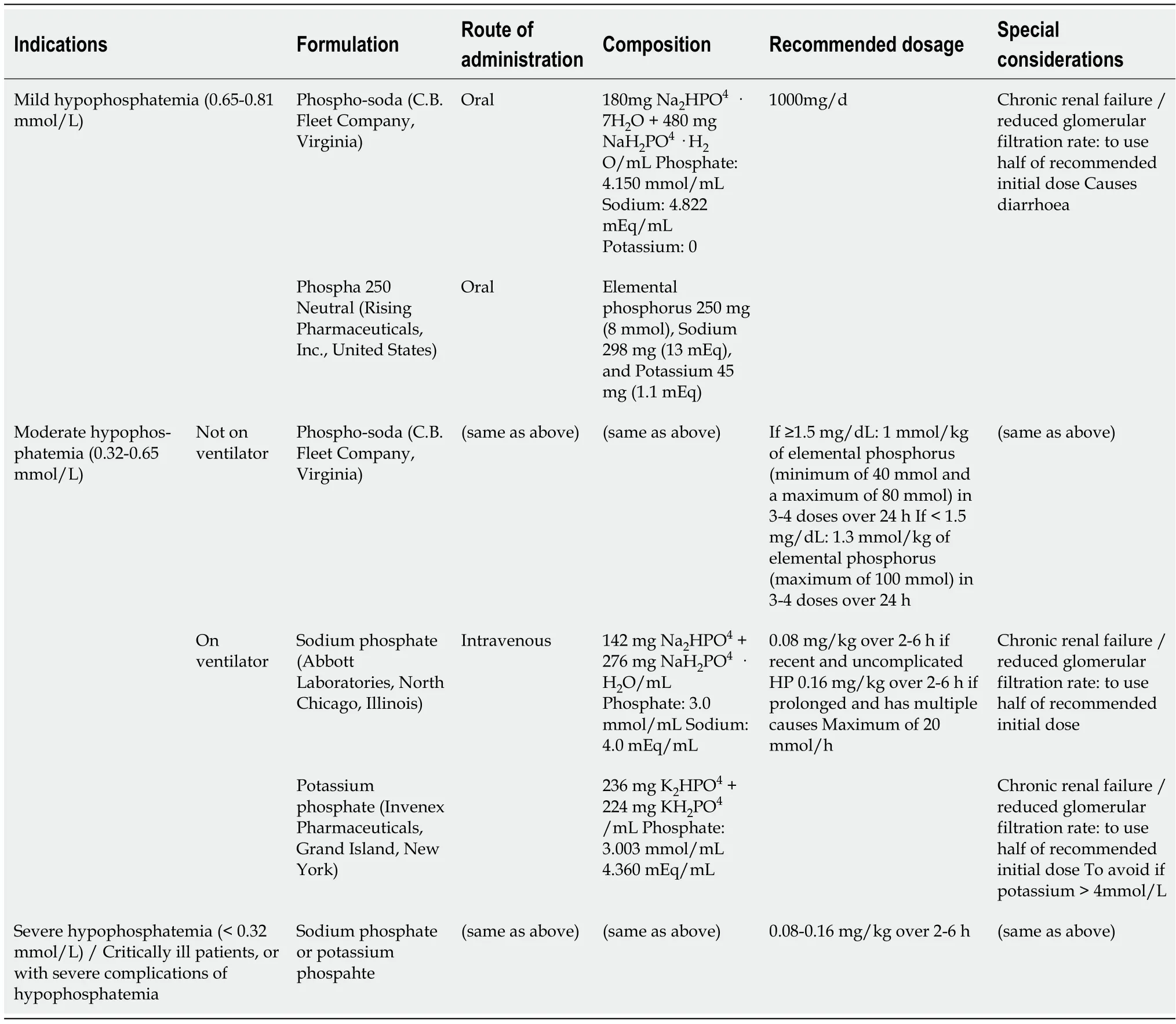
Table 3 Summary of phosphate replacement regimes for hypophosphatemia
Similarly, for post-hepatectomy, there is no standardized regime for phosphate replacement. Table 1 summarizes the various phosphate replacement regimes and indications for replacement in existing studies for patients with PHH. Indications for phosphate replacement differed largely across the studies, with studies replacing phosphate only for severe PHH (< 1.0 mg/dL),vsstudies which replace phosphate for < 3.0 mg/dL[14,40]. Nevertheless, the benefits of phosphate replacement has been described with reduced post-operative complications and improvement in liver function[11,40]. In view of the lack of standardized protocol for phosphate replacement in PHH, we suggest the use of the same regimen for phosphate replacement in HP (Table 3), with the use of oral replacement for mild-moderate PHH, and intravenous replacement for severe PHH or in critically ill patients.
PROGNOSTlCATlON OF POST-OPERATlVE COURSE FOLLOWlNG HEPATECTOMY
This summarized study and reviewed literature have shown equivocal evidence (Tables 1 and 2), with both benefits and disadvantages of PHH on incidence of PHLF and/or morbidity. However, exclusively for healthy patients with living donor hepatectomy, our literature review showed that these group of patients who had HP were more likely to have PHLF[13,40]. In contrary, patients with diseased liver(underlying malignancy and/or cirrhosis) who undergo hepatectomy may have improved liver regeneration and/or lower PHLF following hepatectomy, or have increase in post-operative morbidity[10,13,14]. This difference in outcome may be attributed to pre-operative nutritional optimisation and phosphate replacement in patients with diseased liver.
PHLF is a dreaded complication following hepatectomy with mortality risk; this is especially so in the context of patients with underlying cirrhosis and/or deranged liver function. Thus far, several studies have devised prognostic factors and prognostic scoring systems for the prediction of PHLF and mortality following hepatectomy[58-61]. Established predictive factors of PHLF include Albumin-Bilirubin score, prothrombin time and Child-Pugh score[58,60,61].
NP has been shown to increase incidence of PHLF; multivariate analysis by Squireset al[13] on 719 patients who underwent major hepatectomy showed that POD 2 phosphate > 2.4 mg/dL (0.78 mmol/L)was associated with higher PHLF (HR 1.78, 95%CI: 1.02-3.17,P= 0.048), major complications (HR 1.57,95%CI: 1.02-2.47,P= 0.049), 30 d mortality (HR 2.70, 95%CI: 1.08-6.76,P= 0.031) and 90 d mortality (HR 2.51, 95%CI: 1.03-6.15,P= 0.044)[13]. Nevertheless, the evidence on the use of phosphate as a prognostic marker of PHLF is scarce, and more studies are required to demonstrate any correlation between phosphate and PHLF.
CONCLUSlON
The pathophysiology behind PHH remains poorly understood. This review summarized existing literature investigating the impact of phosphate on post-operative outcomes following hepatectomy.However, definition of PHH is variable and majority of studies are retrospective with small sample size.Phosphate replacement regimes were not standardized across the studies. The heterogeneity of the reviewed studies limits our understanding of PHH on post-operative outcomes following hepatectomy.Nevertheless, PHH is a common phenomenon and it is important for clinicians to ensure adequate replacement in view of deleterious effects of PHH. Well-designed randomized controlled trials should be conducted to fill in the knowledge gap on the impact of phosphate levels and phosphate replacement in patients undergoing hepatectomy.
FOOTNOTES
Author contributions:Chan KS and Mohan S acquired the data, prepared the tables, drafted the article and approved the final version of the manuscript to be published; Chan KS interpreted and analysed the data and prepared the figures; Shelat VG conceptualized and designed the study and made critical revision of the manuscript and approved the final version of the manuscript to be published.
Conflict-of-interest statement:All authors declare no conflicts of interest.
Open-Access:This article is an open-access article that was selected by an in-house editor and fully peer-reviewed by external reviewers. It is distributed in accordance with the Creative Commons Attribution NonCommercial (CC BYNC 4.0) license, which permits others to distribute, remix, adapt, build upon this work non-commercially, and license their derivative works on different terms, provided the original work is properly cited and the use is noncommercial. See: https://creativecommons.org/Licenses/by-nc/4.0/
Country/Territory of origin:Singapore
ORClD number:Kai Siang Chan 0000-0001-9533-801X; Swetha Mohan 0000-0001-8463-1579; Vishal G Shelat 0000-0003-3988-8142.
S-Editor:Wang LL
L-Editor:A
P-Editor:Wang LL
杂志排行
World Journal of Hepatology的其它文章
- Long-term liver allograft fibrosis: A review with emphasis on idiopathic post-transplant hepatitis and chronic antibody mediated rejection
- Simple diagnostic algorithm identifying at-risk nonalcoholic fatty liver disease patients needing specialty referral within the United States
- Higher cardiovascular risk scores and liver fibrosis risk estimated by biomarkers in patients with metabolic-dysfunction-associated fatty liver disease
- Prevalence of sarcopenia using different methods in patients with non-alcoholic fatty liver disease
- Metabolic-associated fatty liver disease is associated with low muscle mass and strength in patients with chronic hepatitis B
- Effect of probiotics on hemodynamic changes and complications associated with cirrhosis: A pilot randomized controlled trial
